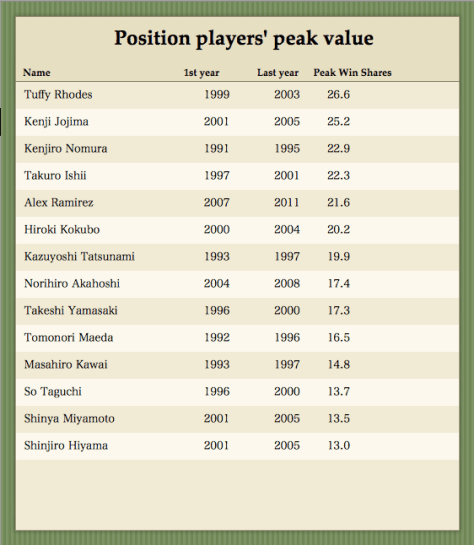
Eighteen players to choose from and seven votes.
I’ve noted in several recent posts that the membership of Japan’s baseball Hall of Fame is badly skewed toward pitchers, first basemen and outfielders. That will change within the next 10 years when Tadahito Iguchi and Kazuo Matsui are on the ballot, since they were among the most valuable players in the game during their heyday.
To review, here is this winter’s players division ballot, with the percentage of votes received in last year’s ballot:
- Kazuyoshi Tatsunami 2B 65.8
- Shingo Takatsu RP 45.9
- Masahiro Kawai SS 35.9
- Kenjiro Nomura SS 28.5
- Tuffy Rhodes OF 22.8
- Hiroki Kokubo 3B 21.7
- Masumi Kuwata SP 21.2
- Takuro Ishii SS 19.3
- Kenji Jojima C 14.1
- Shinji Sasaoka SP 9.5
- So Taguchi OF 7.9
- Norihiro Akahoshi OF 5.4
- Kazuhisa Ishii SP new
- Shinya Miyamoto SS new
- Tomonori Maeda OF new
- Takeshi Yamasaki IB new
- Shinjiro Hiyama OF new
- Alex Ramirez OF new
My picks were:
- Kazuyoshi Tatsunami
- Shingo Takatsu
- Tuffy Rhodes
- Hiroki Kokubo
- Takuro Ishii
- Kenji Jojima
- Alex Ramirez


The big debates were between closer Shingo Takatsu and starter Masumi Kuwata, and between outfielders Tomonori Maeda and Alex Ramirez.
Kuwata won a Sawamura Award as Japan’s most impressive starting pitcher, but in historic terms his career would be one of the weakest among starting pitchers in the Hall of Fame. Takatsu was a solid — if not dominant — closer on a team that won five pennants.
Ramirez finishes behind Maeda in career win shares and was not as much a complete player as Maeda was a youngster before injuries took their toll on his career. But Ramirez had a much-higher peak ceiling and won two straight Central League MVP awards.
Some other notes:
- Tatsunami, even at his peak, was never considered one of the league’s elite players. He never led the Dragons in win shares in any one season. His genius was in being really good for a long, long time, and that’s worth something.
- Takatsu is a relief version of Tatsunami, a very good reliever for a long time in a generation when closers were usually burned out after a season or two.
- Rhodes should be a stronger candidate than he has been. He was a league leader in an offensive category 18 times. No player has ever led his league in as many as 16 categories and not been elected to the Hall of Fame.
- Kokubo was a leader on both the first Hawks dynasty in Fukuoka under Daiei and the second under SoftBank before his retirement.
- Takuro Ishii was a very similar player to Tatsunami, but with more defensive value and fewer extra bases.
- Jojima was Japan’s premier catcher from 1999 to 2005 during his time with the Hawks, then spent four years in the majors before returning to play at a high level for the Hanshin Tigers.
On second thought, I looked at each position player’s highest peak, by measuring their average win shares over each five-year period of their career (see table below). The surprise for me here, is not that Rhodes and Jojima are head and shoulders above everyone else but that Kenjiro Nomura, whom I didn’t vote for, and Takuro Ishii, whom I did, rank so much higher than Ramirez, and that through this analysis, Kokubo becomes a corner-infield version of Tatsunami, whose peak value ranks seventh out of 14.
When you look at all of each player’s running five year averages, however, it is clear that Nomura’s extreme peak was briefer than Ishii’s. It is also clear that Ramirez and Nomura were very close in both peak and total value. The real question of who belongs and who doesn’t was not between Tomonori Maeda and Ramirez, but between Nomura and Ramirez and Kokubo.

